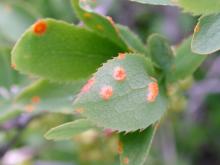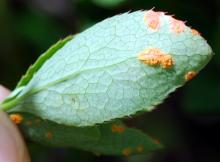See:
Wheat (Triticum aestivum) - Stem Rust (Black Rust)
Oregon Grape (Berberis aquifolium) - Rust
Cause Several rust fungi are reported to occur on barberry including Cumminsiella mirabilissima, which is autoecious (can complete their life cycle on this one host), Puccinia brachypodii var. arrhenatheri with several grasses as alternate hosts, P. koeleriae, with Koeleria cristata as the alternate host, P. graminis, with wheat, barley and rye (stem rust or black stem rust) as alternate hosts, and P. striiformis, with wheat and barley (stripe rust or yellow rust) as alternate hosts. Although P. striiformis f. sp. tritici can infect common barberry, weather conditions in eastern areas are unfavorable for its development.
These rusts are usually minor problems on the widely cultivated ornamental Japanese barberry (Berberis thunbergii). The greatest concern is for development of stem and stripe rust on common barberry (B. vulgaris), which is not sold or produced commercially due to quarantine restrictions for black stem rust in several states. Shipments of susceptible or infected nursery stock have been rejected by some states; however, the movement of stem rust-resistant cultivars is not regulated.
Infection of barberry or Oregon grape by Puccinia spp. takes place in the spring from wind-blown basidiospores produced on the grass stubble of alternate hosts. Basidiospores generally do not travel very far (less than half a mile) so local sources are important. Pycnia (spermogonia) form on the upper surfaces of young leaves and fruit and are followed by showy, yellow-orange aecia that develop on lower leaf surfaces and fruit. Spores from the aecia are wind-blown and infect nearby grass hosts; they are not able to reinfect barberry or Oregon grape.
Barberries planted around old homesteads in eastern Washington and eastern Oregon have been associated with outbreaks of stem rust on wheat. A federal Barberry eradication program to eradicate common barberry in eastern Washington began in the 1940s and continued through the 1970s. Although the program was focused in Washington, some survey and eradication efforts also occurred in Oregon and Idaho. The program was very successful in eliminating over 200,000 barberry bushes; however, it was incomplete and some plants have grown back. Removal of barberry plants near wheat fields is still recommended to reduce stem rust.
Symptoms The aecial stage of Puccinia graminis and P. striiformis occur on leaves and fruit. On leaves, aecia appear as bright yellow-orange spots on the upper leaf surface with horn-like appendages on the lower surface. On fruit, the orange-colored aecia may occur anywhere. Aecia may extend up to 5 mm above the leaf or fruit surface. Some authors have described the disease as bright orange spotting. Pycnia are small and barely visible with the naked eye as dark-colored specks that occur in red areas on leaves. Leaf tissue near pycnia and aecia is generally discolored yellow-red. Severe infections can cause defoliation.
Cultural control
- Avoid using overhead irrigation.
- Remove infected leaves when found.
- Do not grow alternate hosts next to nursery stock.
- Produce only resistant cultivars or species. Production and shipment of common barberry is regulated by the USDA Animal and Plant Health Inspection service (7CFR 301.38). Only barberry cultivars resistant to Puccinia graminis, of which there are many, can be imported into Oregon (OAR 603-052-0800) and Washington (WAC 16-472).
- Removal of barberry plants near wheat fields is still recommended to reduce stem rust.
Chemical control Apply regularly in the spring as new growth begins.
- Armada 50 WDG at 3 to 9 oz/100 gal water. Do not use a silicone-based surfactant. Not for nursery or greenhouse use. Group 3 + 11 fungicide. 12-hr reentry.
- Eagle 20 EW at 6 to 12 fl oz/100 gal water. Group 3 fungicide. 24-hr reentry.
- Heritage at 1 to 4 oz/100 gal water plus a non-silicone-based wetter sticker. Group 11 fungicide. 4-hr reentry.
- Myclobutanil 20 EW T&O at 6 to 12 fl oz/100 gal water plus spreading agent. Check label for possible phytotoxicity. Group 3 fungicide. 24-hr reentry.
- Terraguard SC at 2 to 8 fl oz/100 gal water. Group 3 fungicide. 12-hr reentry.
- Trinity at 4 to 12 fl oz/100 gal water. Group 3 fungicide. 12-hr reentry.
References Bockus, W.W., Bowden, R.L., Hunger, R.M., Murray, T.D., Smiley, R.W., and Morrill, W. (eds.) 2010. Compendium of Wheat Diseases and Insects, Third Edition. APS Press, Minneapolis.
Wang, M., Wan, A., and Chen, X. 2015. Barberry as alternate host is important for Puccinia graminis f. sp. tritici but not for Puccinia
striiformis f. sp. tritici in the US Pacific Northwest. Plant Disease. 99:1507-1516.



